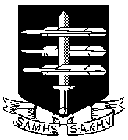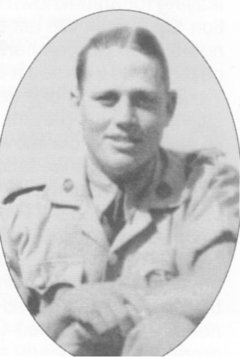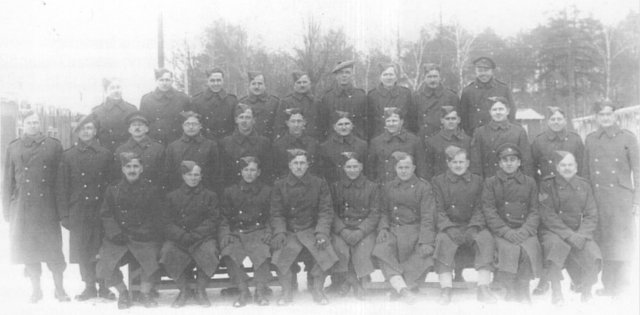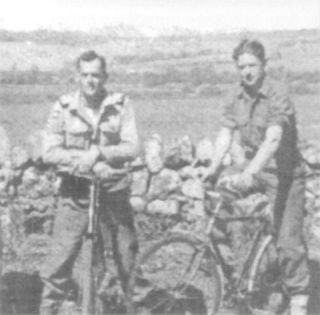

 The South African
The South African
We are very familiar with the history of the Second World War as related by those in command, who always seem to publish extensive memoirs. However, the story of the ordinary soldier is often less well served by publications such as ours. Recently the Journal received the following 'Memoirs' from Neville Dugmore of Potchefstroom. His recollections possibly reflect much of the experience of many serving Soutfi African volunteers between 1939 and 1945. Now more than 80 years old, he clearly remembers how he experienced VE Day, 8 May 1945, in London, with crowds of British civilians and others standing near Nelson's Column in Trafalgar Square, and how the crowd cheered when the news was broadcast that the War in Europe was over. By the time V J Day came around in August, he was safely back in South Africa-Marjorie Dean, 2005

A youthful Neville Dugmore at Gilgil, East Africa, 1940.
(Photo: N. Dugmore).
My name is Neville Sydney Dugmore and I was born in Potchefstroom on 3 December 1920. I attended the Central Primary School, and then went on to Potchefstroom Boys' High. I matriculated in 1938 and went to work in Durban for a wholesale firm, S Butcher and Sons, that same year. I was excited to be called up to do my Active Citizen Force training there. Parades were once a week at Old Fort Road, Durban, and I was given the rank of corporal and an army number, which I still remember - 3651.
I can also remember quite clearly, at 10.00 on Sunday, 3 September 1939, that three friends and I, all living together at the YMCA Esplanade, were lying on the sand at South Beach Durban, enjoying our day off, when we heard a message loud and clear over the loudspeakers, saying that Britain and its Allies had declared war on Germany. This was something of a new experience for us! We jumped up, picked up our towels and ran all the way back to the YMCA, singing, 'we are all going to war'. Little could we imagine what lay ahead!
First of all, we had to get our parents' consent, being still under 21 years of age. We took the oath of serving anywhere in Africa and beyond its borders. For this we were issued with two red lapel tabs and two yellow and green diamond-shaped flashes, which we had to attach to our uniforms on the shoulder straps. They indicated that we were volunteers in the 1st South African Divisional Ammunition Company, attached to the 5th SA Brigade, comprising the 3rd Jocks (Transvaal Scottish), 1st SA Irish and 2nd Botha regiments.
In April 1940, our unit was mobilised and sent to a training camp called Zonderwater. This lasted only seventeen days, and then we were told we would be leaving for an unknown destination 'Up North'. We left by train, non-stop to Durban harbour. The next day we boarded a ship, the Takliva, and only one day after sailing were my parents informed, so secret were our movements.
A week later we landed in Mombasa, Kenya. Luckily no U-boats had found us. From here we travelled by train to Nairobi, to a camp called Kabeti, and were put to work erecting bungalows for troops. We then moved on further north to a place called Gilgil. I was promoted to sergeant, given another stripe, and we continued building more bungalows for other troops and ourselves. From Gilgil, we transported supplies of petrol, ammunition, and food to the Abyssinian border, to a place called Marsabit and also to Fort Mega.
This campaign did not last long, and then my unit, consisting of 53 three-ton Ford trucks, fully laden with ammunition, left Kenya for Egypt, travelling across the Nubian Desert. We had been driving on the road for some days when our engineers stopped us as they had located some unexploded mines buried in the road.
While crossing the desert, one of my men became separated from the convoy. We placed empty petrol cans indicating where he had last been seen, and our convoy continued on for three days. To our surprise and joy we came across him, his loader and vehicle. We had called him 'Buck Jones' because of the way he drove over the sand dunes. He and his loader were hungry and thirsty, having drained the truck's radiator. After receiving food and water and some medical attention, both survived to tell the tale. It took us a whole month to make the journey, and I am proud to say that we lost only one three-ton truck, because of a burnt-out clutch.
In Egypt, we set up camp in the desert outside Alexandria for a few months. One night, during an air raid, two of us picked up a wounded Egyptian and took him to hospital. We were reprimanded, as we should not have handled a civilian casualty! On 21 November 1941, we moved forward, reaching a place called Sidi Rezegh. At about 10.00 on the morning of 23 November 1941, the entire 5th SA Brigade was overrun by a German Panzer division. My convoy was bombed by Stukas, machine gunned and shelled. I lost one driver and a vehicle. I remember crawling in the sand under my truck's engine for protection from machine-gun bullets and bombs falling all around me. I prayed to God that I would not lose my eyesight, or an arm or leg. At one stage I ended up in 'no man's land', and remember dodging an anti-tank shell that came toppling at me after hitting the sand. Machine-gun bullets sounded like a swarm of bees going over me, while I lay in my slit trench.
What remained of 5th Brigade became prisoners of war (POWs). On the day after our capture one of our tanks came right up to us. We tried to warn them off, but it was too late as a mobile 88mm gun shot them at point-blank range. Two of the crew managed to crawl out, but the others could be smelt burning all night. Our Italian captors were none too gentle - they bashed us with rifle butts and, when we asked for water, they would empty their water bottles out on to the sand in front of us. (In Germany we were treated with respect as soldiers.) From Sidi Rezegh, we were marched for a few days, with very little water or food, and then put into trucks and taken to a place called Benghazi on the coast, where we were put into huge warehouses. It was here, on a concrete floor with no blankets, that I awoke to spend my 21st birthday on 3 December. Rations for the day were cabbage soup and four ounces of bread.
On the morning of 8 December 1941, we were marched to the docks and herded on to a ship called the San Sebastian, formerly an Italian liner, and were battened down in the holds. A torpedo hit us up front at 15.00 that same day - I can still hear the sound of the terrific explosion - and the next minute all I saw was blue sky and felt icy water. We had been attacked by one of our own Allied submarines! They did not know that ours was a POW ship - no Red Cross signs had been put up. Of the 2 000 men on board, some 600 were killed or drowned. At this stage, I was wearing takkies, having lost my boots in the desert because of blisters. At the time of the blast the captain, all crew and guards had taken to the lifeboats, leaving nothing for us.
Again God and Nature helped us, because the wind changed direction, blowing the damaged ship on to the rocks of a Greek island called Putras. Those of us who were still alive remained on board all night, with the waves pounding the ship on to the rocks, leaving us cold and wet. On the following morning, a fellow South African, named Bernie Friedlander, swam ashore, having stripped to the waist, attached to a long rope to tie to the rocks on shore. We all took it in turns to slide down the rope, then work our way to safety by means of 'hand over foot'. I lost my takkies in the course of this effort, so landed in Greece with only socks on my feet, on 9 December 1941.
We spent nearly five months sleeping in old castles, with no blankets, ice and snow everywhere. From there we were marched to an open piece of ground, fenced off, which we called 'Dysentery Acre' - that name speaks for itself. We slept in small bivvy tents, less than two metres long, two to a tent with straw for beds. After living like this, in mud and slush one day, frozen the next, for a few months, being pestered by lice and fleas from the straw, we were marched off somewhere else and out again into two large warehouses. This we called 'Domani Mansions', a reference to the standard reply given to us when we asked the Italians when we were going to be moved on. (They would always answer 'Domani', meaning tomorrow, and tomorrow took months to come.)
We were allowed outside one by one, to relieve ourselves once a day. Our rations were one bowl of cabbage soup and 4oz [125gm] bread per day. Housed in two buildings, with a thousand men in each, sleeping on bunk beds with straw mattresses, we had more bugs, more lice and more fleas! In this building I heard an English soldier called Johnnie Rae sing a song called 'Begin the Beguine'. He had no music, just his voice. You could have heard a pin drop as he sang. I shall never forget it, and it became my favourite song.
In the first week of March 1942, we were herded into another Italian ship, but this time we were all issued with life belts!

Stalag 344, Lamsdorf, Poland, 1944
(Photo: By courtesy, N Dugmore).
We sailed up the Adriatic to Port Bari, and then to Brindisi, where we were put ashore and placed in a fenced camp with no buildings. It was here that I ate orange peel and cooked grass to stay alive. From here, we were taken by truck to our first permanent POW camp, called Campo 52, near the town of Chiavari, on the Gulf of Genoa. We arrived on 9 May 1942. Here, I received my first pair of Italian boots, with squares of calico for socks. We were very lucky because this camp had already been receiving Red Cross parcels. For the first time since our capture, we had proper meals. The rations in the camp included a mug of black coffee (no sugar) early in the morning and, at midday, a macaroni stew and bread called pane, about 4oz in weight.
I was put in charge of a two-storey building. This was Building 21, with sixteen double bunks on each floor, 64 men in all. The rations were brought to our hut and I was responsible for issuing them. I drew up a list of all the men, so that each man had his turn to be first in the queue. 'Red Cross' parcels were issued on Tuesdays and Fridays, one parcel between two men.
There came a time when no parcels arrived - the Italians said the RAF had bombed the train. (We thought they were helping themselves.) I had saved a small tin of oats porridge and it was a cold day, so I decided to go out into the square and cook it. The South Africans had learned from the English, New Zealand and Australian prisoners how to make what we called 'blowers' for cooking in. There were two models, a bellows and a fan type. I had by now built what was called a 'double action blower', made from empty Red Cross parcel tins. We could boil a dixie of water in three minutes! That day, the boys were playing with a football, and what a calamity when it landed right in my dixie of oats, spilling it all on the ground and leaving one hungry POW to go and sleep it off!
One of my friends in the camp was Rodney Vial. We heard from his mother that while baking puddings for the Red Cross parcels, she had lost her wedding ring. Believe it or not, another South African POW in our camp had received the very pudding, with the ring inside, and he returned it to Rodney!
Another of my friends was Eric Webber, a medic with whom I shared my Red Cross parcels. He and I had to break the ice every morning to get a cold shower. He had been wounded in the leg, and was lucky enough to be repatriated. On his arrival back in Johannesburg, he went to see my parents in Potchefstroom, and told them I was alive, well and healthy.
Some POWs were very inventive. One made a whole chess set out of toothbrush handles, melted down with acetone. He was offered £400 for it, but would not sell, as he wanted to take it home.
I had been in Campo 52 for sixteen months when, on 11 September 1943, Italy capitulated and the Germans took over. After a few days under their command, we were marched to Chiavari Station and herded on to cattle trucks (with standing room only). The trip lasted ten days and ten nights. It was a most degrading experience as the train stopped only once a day to allow the men to relieve themselves. All the guards would say was: 'Scheizen in Kostbaken!' [sic], i.e., 'use your dixie'.
On the eleventh day, we arrived in a town called Moosburg near the city of Munich. For a few days, we were camped next to a camp of Russian POWs who did not receive Red Cross parcels and who were really starving. The Germans sent wolfhounds into their camp to find out any possible escape routes. The next morning, the dog bones were thrown over the fence, so no more dogs went in. From Moosburg, we were transported by road to a permanent camp called Lamsdorf, near Breslau, now called Wroclaw.

Neville Dugmore, Robie Robertson, the Des Fly,
Oxley Oxlin with the Vicar and his wife.
In Poland, temperatures fell as low as minus 30° C on some days and nights. Once a day, we were issued with a piece of black bread (the usual 4 ounces!), a Klim tin ladle of soup made from cabbage and potatoes, and a mug of black coffee with no sugar. It was in this camp that the English POWs, being the first to arrive there, had started digging an escape tunnel. The digging started in the RAF bungalow, near the combustion stove, and we were all asked to contribute by removing a couple of wooden slats from our bunks to shore it up. The digging of the tunnel had been going on for months, and they were finally ready to break out on the other side of the fence. The Gestapo came right into the bungalow, right up to the combustion stove, tapping the floor and finding the entrance. To cut a long story short, it was discovered that a Canadian POW had informed on the scheme. He was found outside, frozen stiff and with his throat cut, the next morning!
In December 1944, the Russians started advancing towards Germany, across Poland, so the Germans forced us to march southwards in a zigzag course doing about fifteen to twenty kilometres per day, sleeping in haystacks at night. There was precious little to eat (again the ubiquitous cabbage and potato soup, and black coffee once a day). I remember that, while on this march, I spotted a hen on her nest! I broke rank, gathered the four eggs from under her, and concealed them under my bunny jacket. That night, I told my pals that we would have eggs for supper! Imagine my disappointment when they turned out to be china eggs, put there to encourage a broody hen! But on another occasion, I was able to do a quick barter deal with a German baker, swapping a hundred carefully hoarded cigarettes for four round, fresh loaves nearly 16 inches (40cm) long and two inches (5cm) thick! We ate well for a few days!
The march lasted five months and we covered some 600 miles (965km), ending up, in mid-April 1945, in the city of Munich where we had started from so many months before! Suddenly, on 29 April, we heard the rumbling of tanks all around us, and our guards fled. It was General Patton, with his army! A few American soldiers asked us what we would like. With no hesitation, we said, 'Food'. So a cow and a pig were shot and, in no time at all, cooked and ready to be eaten together with our allocation of what the Americans called 'K' rations.
The Americans then left us and we made our own way into Holland and Belgium, only to be brought back again across the Rhine into Dusseldorf, for interrogation. They did not realise that we were South Africans, as many of us spoke Afrikaans, which was very close to German! We were taken to Brussels and then flown in Lancaster bombers across the English Channel, landing at Croydon Airport, near London. This was on 5th May 1945. We were given a wonderful reception, served with tea cake and sandwiches. We were issued with new uniforms and my first pair of leather boots since I had been sent some by my parents in a Red Cross parcel.
We spent three-and-a-half months in Britain and travelled to a small town called Dingwall, north of Inverness in Scotland, where we stayed with a vicar and his wife. We were each given a bike to ride, all round the beautiful countryside over babbling brooks and stone bridges. We shocked our British hosts by helping ourselves to a bunch of grapes from the table. At that time, they cost over £5 bunch - not at all like home!
Finally we heard that our ship, the Athlone Castle, was ready to take us home to South Africa. The voyage took about ten days, and we docked in Cape Town on 2 August 1945. From here, the journey was by passenger train, with the luxury of bunks and blankets. We arrived in Potchefstroom in the early hours of 3 August. My parents were at the station to meet me, along with a tall young man, whom I did not recognise, who offered to carry my bag! I said to him, 'Who are you?' and he replied, 'Your brother'. I did not know him after an absence of five and a half years. He had been in primary school when I had left South Africa.

Above: Des Fly and Oxley Oxlin, Ingwall, Scotland, 1945.
(Photos: N Dugmore).
After a joyful reunion with family and friends, I resumed my work in Durban with S Butcher & Sons in Durban on 16 October 1945. I could never understand why, when I applied soon afterwards for a government loan, all I got back was a letter saying that I was well set and did not require it because I was going to start work in the family business. I had been away for five and half years - for most young people the best years of their lives - fighting, so I took this as a real slap in the face, as did others amongst my wartime companions.
Last Word. When I later went to live in Nelspruit, I met up again with Bennie Friedlander, and every year we had a celebration to remember the Fall of Sidi Rezegh and the sinking of the San Sebastian and our survival of both events!
Return to Journal Index OR Society's Home page
South African Military History Society / scribe@samilitaryhistory.org